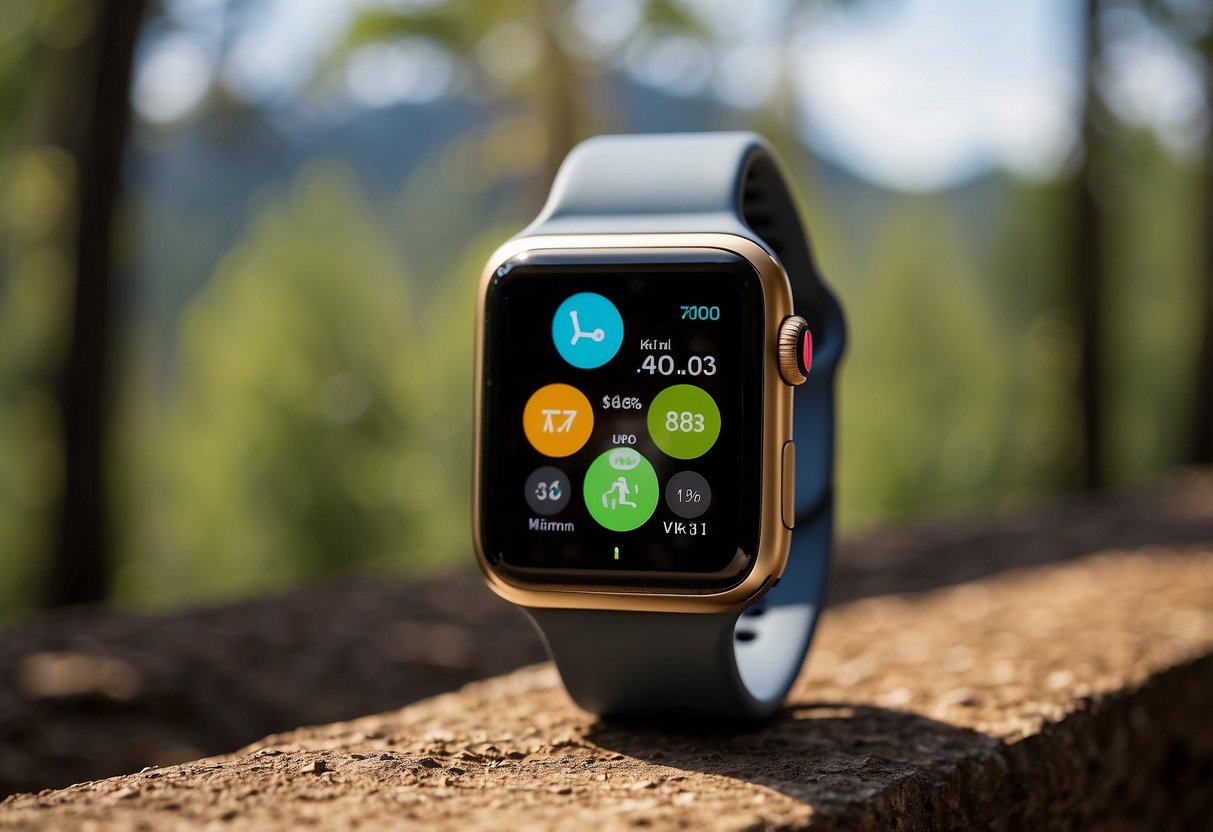Running is a great way to stay fit, and many runners use an Apple Watch to enhance their workouts. These smartwatches come with several features that can make running more enjoyable and productive. Whether you’re a beginner or a seasoned runner, knowing how to make the most of these features can greatly improve your running experience.

What benefits can the Apple Watch bring to your running workouts? With the right tips and tricks, you can monitor your progress, set goals, and stay motivated throughout your fitness journey. From tracking your distance and pace to creating custom workout plans, the Apple Watch can be an invaluable tool for any runner.
Ensure Proper Fit

Getting the right fit for your Apple Watch is crucial for accurate tracking.
Make sure the watch is snug but comfortable on your wrist. A loose strap can cause inaccurate heart rate readings.
When running, you don’t want the watch shifting around. Consider using a sport band for a secure fit.
Have you noticed any skin irritation? Adjust the fit or try a different band material, like fluoroelastomer, which is gentle on skin.
Choosing the right fit will keep your Apple Watch performing at its best during your workouts.
Activate Power Saving Mode
To save power during your runs, activate Power Saving Mode on your Apple Watch. This can help extend your battery life, especially during long workouts.
First, open the Settings app on your watch. Scroll down and tap Battery. Here, you’ll find the option to turn on Low Power Mode.
You can choose to turn it on for 1, 2, or 3 days. This mode disables some features but keeps the essentials for your workout.
For a more efficient workout, consider pairing your watch with a Bluetooth heart rate monitor. This will disable the on-watch monitor, conserving additional battery power.
Utilise the Apple Watch Nike Run Club App
Using the Nike Run Club app on your Apple Watch can enhance your running experience.
It’s easy to get started. Open the app and tap the Start button on the main screen for a quick run. For more control, scroll down and choose a custom distance or duration for your run.
One of the best features is the guided runs. These sessions include coaching from Nike experts and can help you stay motivated. You can track your performance, set goals, and challenge yourself with speed runs.
Connecting the app to other devices, like a Garmin watch, is straightforward too. Open the Nike Run Club app on your phone, tap the Settings cog, and select Partners to connect.
Using the Nike Run Club app turns your Apple Watch into a powerful running partner.
Customise Workout Goals

Setting workout goals on your Apple Watch can really help boost your fitness routine. You can set a target for calories, distance, or time. This makes it easier to track your progress.
To do this, open the Workout app. Choose your preferred workout type. In the upper-right corner, tap the three-dotted button. Here, you can set your specific goals.
Adjusting your workout goals ensures that you stay motivated and focused. Whether you’re aiming to burn a certain number of calories or run a specific distance, custom goals can keep you on track. Make sure to review and update your targets regularly to keep challenging yourself.
Enable Heart Rate Alerts
Setting up heart rate alerts on your Apple Watch can help you stay within your ideal workout zone. This can be particularly useful for runners.
To start, open the Settings app on your Apple Watch. Navigate to Workout and then Heart Rate Zones.
You can choose to set custom zones by tapping Manual, then select the zone and enter your desired lower and upper limits.
These alerts will keep you informed during your run, whether you need to pick up the pace or slow down. It’s a great way to optimise your training sessions.
Sync with Strava
To get started, open the Strava app on your Apple Watch. Then, follow the steps to connect it to your Apple Health app.
First, open the Strava app on your iPhone. Tap on You at the bottom, and head to Settings. Under Applications, Services, and Devices, select Apple Health.
For a seamless experience, ensure that both apps are updated. This helps in transferring your workouts smoothly.
Syncing with Strava allows you to share your runs and track your progress easily.
Track Cadence
Tracking your running cadence on your Apple Watch can help you improve your running efficiency. Cadence measures the number of steps you take per minute. A higher cadence typically means shorter, faster steps, which can reduce the risk of injury.
To monitor your cadence, open the Workout app on your Apple Watch. Select Outdoor Run and tap the three dots icon. Then, choose Edit and toggle on Metrics 2.
You can see your current and average cadence during your run by looking at your watch face. This data helps you adjust your pace accordingly.
Focusing on a consistent cadence can make your runs smoother and more enjoyable.
Monitor Heart Rate Zones
When you’re running with your Apple Watch, it’s important to keep an eye on your heart rate zones.
Your watch uses your max heart rate and resting heart rate to split your heart rate into different zones. These zones range from light to high intensity.
Zone 1 (50-60%) is for light intensity.
Zone 2 (61-70%) is moderate intensity.
Zone 3 (71-83%) involves hard intensity workouts.
To set up, open the Workout app on your watch. Choose a workout type, tap the More button, go to Preferences, and then select Heart Rate.
You can also customise these zones in the Watch app on your iPhone.
Use the Built-In Music Player

Using the built-in music player on your Apple Watch can make your runs more enjoyable. To sync music, place your Apple Watch on its charger.
Next, open the Apple Watch app on your iPhone. Tap the My Watch tab, then Music, and select Add Music. Choose the songs or playlists you want to sync.
Remember, syncing can take some time since it uses Bluetooth.
Once the music is on your watch, you can listen to it using Bluetooth headphones. You won’t need to carry your phone, making your run more convenient. Enjoy your favourite tunes while you run!
Take Advantage of Interval Training Features
Using interval training with your Apple Watch can boost your performance. This feature helps you alternate between high-intensity and low-intensity phases in your workout.
To get started, open the Workout app on your Apple Watch. Choose the workout type that matches your activity, like Outdoor Run. You can then set up your intervals by specifying the duration and intensity.
You can also create custom workouts. This allows you to choose how many times you want to repeat each interval set. After setting your intervals, tap the Cooldown button and choose your cooldown type.
Remember to check your metrics during your workout. The Apple Watch lets you monitor important data, which can help you adjust your performance in real-time. Taking full advantage of these features can make your runs more efficient and enjoyable.
Setting Up Your Apple Watch for Running
To optimise your running workouts with your Apple Watch, it’s essential to select the appropriate settings and understand the features of WatchOS that can enhance your running experience.
Choosing the Right Settings
First, ensure your personal data is correct. Update your weight, height, and age in the Health app. Precise information helps the watch provide accurate metrics.
Next, in the Workout app, choose the running type: Outdoor Run or Indoor Run. To customise, tap the More button. You can set goals for distance, time, or calories. This keeps you motivated. Under the My Watch tab, turn on Auto Pause if you plan to stop frequently during your run. This will pause your workout automatically when you’re not moving.
Make sure Location Services is enabled for accurate GPS tracking. This feature helps you track your route and pace.
Understanding WatchOS Features
WatchOS offers features designed to improve your running workouts. Pacer lets you set a target pace and alerts you if you’re behind or ahead. This is useful for training consistency.
The Custom Workout feature allows you to create a personalised workout by adding warmup, work, and cooldown stages. Tap “Add” to include intervals for work and recovery, selecting your goal type each time. This is perfect for interval training.
Heart Rate Zones keep track of your effort, showing if you’re in the right zone for your goals. To use this, navigate to the Heart Rate settings.
With Haptic Feedback enabled, you get a tap on your wrist for each mile or kilometer run, so you can focus on running without constantly checking the watch.
Remember, keeping your watchOS updated will ensure you have the latest features and optimisations. Use these tips to make every run count with your Apple Watch.
Enhancing Your Running Workout
With the Apple Watch, you can take your running workouts to the next level by monitoring your heart rate and incorporating interval training. These features help you improve your fitness and achieve better results.
Using Heart Rate Monitoring
The Apple Watch has built-in heart rate sensors that track your heart rate during your run. This helps you understand how hard you’re pushing yourself. You can set up custom heart rate zones in the Fitness app, which will alert you when you are in different zones. This helps you maintain your desired intensity level.
By monitoring your heart rate, you can make sure you’re working hard enough during high-intensity segments and recovering properly in easier segments. This balance is crucial for building endurance and improving overall performance.
Incorporating Interval Training
Interval training involves alternating between high-intensity and low-intensity periods during your run. This method helps to improve both your speed and endurance. To set this up on your Apple Watch, open the Workout app and choose a running exercise. Use the three-dot icon to create a custom workout and set time or distance for both your high and low-intensity intervals.
Interval training is great for burning more calories and building muscle. It also makes your workout more engaging, so you’re less likely to get bored. For example, you could sprint for 30 seconds, then walk or jog for a minute to recover before repeating.
By integrating these features into your routine, your runs can become more effective, pushing you closer to your fitness goals.
Post-Run Recovery Tips
After a run, focusing on recovery helps your body heal and prepares you for your next workout. Apple Watch offers tools to aid in analysing workout data and cooling down with breathing exercises.
Analyzing Your Workout Data
Your Apple Watch gathers important information during your run. After you finish your workout, take time to review this data. Check metrics like heart rate, pace, distance, and elevation gain. These details can help you understand how your body performed and where you can improve.
You can find your workout data in the Fitness app on your iPhone. Look for trends in your performance. For example, if your heart rate is consistently high, you might need to adjust your training intensity. Use the data to set realistic goals for your next run.
Remember to also consider how you felt during the run. Personal insights combined with the data will give you a fuller picture of your performance.
Utilising the Breathing App for Cool Down
Cooling down after a run is essential to help your muscles relax and reduce soreness. The Apple Watch’s Breathing app can guide you through a simple cooldown routine. Open the app and choose a quiet place to sit or stand comfortably.
The Breathing app helps you focus on deep, steady breaths for a few minutes. This not only aids in relaxation but also lowers your heart rate gradually, which is better for recovery.
Follow the guided breathing session, paying attention to the rise and fall of your breaths. Doing this regularly can also reduce stress and improve your overall well-being. Incorporate this routine into your post-run habits to help your body recover more effectively.







